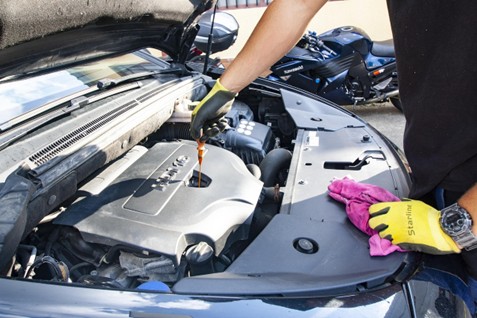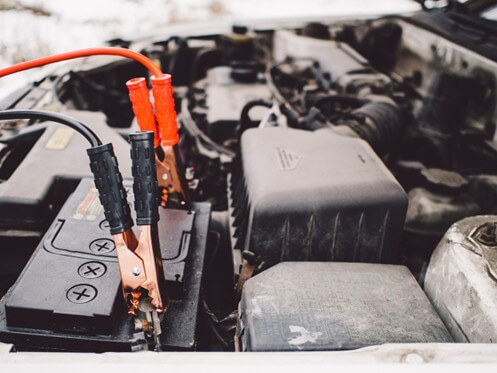If a delivery truck breaks down mid-route or a work vehicle won’t move because of a simple issue, it costs time, money, and unhappy clients. Every day a truck is out can burn $448 to $760. That’s why keeping up with automotive fleet maintenance isn’t just busywork. It’s an integral part of fleet management and way more than just swapping out the oil every few months.
We’re talking about keeping vehicles on the road, avoiding breakdowns, and staying compliant with Department of Transportation (DOT) and Occupational Health and Safety Administration (OSHA) rules. This guide will explain what fleet maintenance is, the challenges, compliance needs, and best practices to keep your trucks functional!
Key Takeaways
- Fleet maintenance combines preventive, corrective, and predictive care to keep vehicles safe, compliant, and operational while reducing downtime and repair costs.
- Technology and telematics improve maintenance efficiency by tracking real-time data, automating schedules, and detecting issues before breakdowns occur.
- Driver training and reporting play a major role in identifying early signs of wear, ensuring compliance with DOT and OSHA standards, and extending vehicle lifespan.
- Consistent record-keeping and compliance management safeguard against fines, support audits, and maintain strong resale value through documented service histories.
- An effective maintenance program drives ROI by lowering fuel costs, extending asset life, improving safety, and keeping fleets road-ready for longer periods.

What Is Automotive Fleet Maintenance?
Automotive vehicle fleet maintenance is the regular care and repair of vehicles that a business owns or leases. It includes preventive maintenance, repairs, inspections, and compliance tracking, guaranteeing that fleets comply with government regulations such as DOT and OSHA. Fleet maintenance aims to maintain vehicles so that they are always available, safe for drivers and the community, and affordable.
Industries of all kinds depend on fleet upkeep, from trucking, delivery, and emergency services to public transit systems, utility, construction, and telecom companies. Fleet maintenance is also needed by rental car agencies, food and beverage distributors, and waste management services to ascertain the day-to-day business operation.
Key Components of Automotive Fleet Maintenance
A modern fleet maintenance program isn’t just one task. It’s a combo of three approaches functioning together. Here are those three key components:
Preventive Maintenance
Preventive maintenance (PM) refers to scheduled maintenance, usually assessed by kilometers the vehicle is driven, to guarantee that an automobile is reliable. Routine procedures consist of oil and filter change, tire service, brake check, fluid and battery check, and examination of belts, hoses, and lights. PM lowers failures, improves safety, conserves fuel, increases vehicle durability, and makes the costs more predictable.
Corrective Maintenance
Corrective maintenance is performed when a problem has been detected by a report, inspection, or breakdown. It aims at restoring the vehicle and takes care of repairs such as engine, transmission, suspension, steering, bodywork, or worn-out components. Moreover, it maintains cars in tune and guarantees that minor problems do not turn out to be expensive.
Predictive Maintenance
Predictive maintenance (PdM) utilizes real-time data to identify when components are likely to break down so that maintenance is performed at the appropriate time. Such tools as telematics, oil analysis, sensors, and diagnostic software monitor the condition of vehicles. This method avoids failures, reduces expenses, and increases the life of the vehicle parts through maintenance on demand only.

Implementing Effective Fleet Maintenance Programs
Good fleet maintenance management goes beyond a simple shop-fix. It requires planning, the right team, clear processes, and the use of technology. Here’s how you can implement effective fleet maintenance programs:
Customized Maintenance Plans
Maintenance that fits all is wasted and likely to cause failures. Schedules should be guided by vehicle type, usage, and environment. For instance, city vans require more brake maintenance than highway trucks, and in extreme weather conditions, more frequent inspections are needed. The ability to use independent checklists of every vehicle category helps avoid under- or over-maintenance.
Driver Training and Reporting
Fleet maintenance starts with drivers. Teach them to do quick pre-trip checks and fill out DOT reports, since things like hard braking or long idling raise repair costs. Also, make it simple for drivers to report warning lights, strange noises, or performance issues, so problems get caught early, before breakdowns happen, and you can save on fuel.
Leveraging Technology
Fleet management software monitors service history, work orders, parts, and costs. Similarly, telematics is used to monitor engine codes, fuel use, idling, driving habits, and location. The combination of these facilitates automates scheduling, minimizes errors, eradicates larger problems, and reduces downtime and repair expenses.
Record-Keeping and Compliance
Record-keeping is crucial for the safety and legality of the fleet. Fleets have to comply with regulations such as DOT standards of service, condition, and emission. Maintenance, repairs, costs, driver inspections, and compliance proof should be digitized. So that audits become more straightforward, warranties are backed, and accountability and resale value are increased.
Benefits of Effective Fleet Maintenance
A powerful fleet maintenance program is not an added cost, but a business asset. The benefits explained below show why it is worth investing in the right systems and processes, with each advantage tied directly to everyday operations:
Enhanced Safety
The greatest advantage of fleet maintenance is safety. Repairs and regular checkups are made to tackle some of the serious causes of accidents, such as brake failure, tire explosion, steering problems, and lighting malfunctions. This safeguards the drivers, population, and the image of the company as well as minimizes risks of lawsuits, insurance claims, and increased premiums.
Cost Savings
One of the greatest benefits of fleet maintenance is associated with the cost savings. A minor problem fixed early in the life cycle, such as a sensor that costs only $50, can save expensive failures and subsequent big repairs. It will also curb any emergency roadside service. Fleet maintenance also maximizes fuel consumption with properly serviced engines and tires and redirects money spent on unforeseen breakdowns to premeditated, scheduled maintenance.
Regulatory Compliance
When a business operates commercial vehicles, regulatory compliance is a crucial requirement. The regulations, like DOT FMCSA standards, require appropriate inspection documentation and compliance with regulations.
A properly designed maintenance program and digital records will keep fleets in compliance. It will save them hefty fines and avoid violations, and the possibility of vehicles being taken out of service.
Operational Efficiency & Uptime
Revenue and customer retention depend on operational efficiency and uptime. Delays in delivery, missed appointments, and unhappy clients show up when vehicles fail to perform the expected tasks. A fleet that is well managed is on the road at all times, and the drivers are always at their destinations on time. This also guarantees that deliveries are timely, routing is better, and that you can manage more work without necessarily adding a vehicle.
Asset Longevity
Asset longevity is concerned with maximizing every investment in any vehicle. Frequent replacement of oil and filters, examination of fluids, and adjustments of parts help in eradicating wear and prolonging the engine’s life. Through appropriate care, a truck that has a 5-year life may serve a 7 or 8-year tenure and thus reduce replacement expenses and extend the investment value.
Resale Value
Resale value is the final reward of strong fleet maintenance. A vehicle with a complete digital service history is far more attractive to buyers, showing it has been properly cared for. When it’s time to sell, this allows you to secure a higher price, recover more of your original investment, and put that money toward new equipment.
Keep your fleet moving with 24/7 fueling
Why react to breakdowns when you can prevent them?
Our comprehensive fleet maintenance and on-site fueling ensure maximum uptime and control over your operating costs.
Common Fleet Maintenance Challenges
Fleet managers and organizations are often exposed to a number of fleet maintenance issues that may make or break their businesses. Below are the most frequent fleet maintenance problems and strategies to address them:
Resource Allocation
In-house maintenance can provide faster turnaround, but may need heavy investment. Whereas outsourcing reduces overheads yet offers experts at reduced rates and longer waiting periods. Most fleets do a combination of both, with routine work handled in-house, complex work outsourced, and on-site repairs provided by mobile fleet management services. The right choice depends on total costs, including downtime and overhead, not just labor.
Compliance Complexity
Fleet maintenance entails adherence to federal and state regulations, which vary. The DOT controls safety, inspection, and driver reports, whereas the EPA regulates emissions and hazardous materials. Additional requirements may also be provided by states.
Aging Vehicles
The decision between repair and replacement is not an easy one, as older vehicles are associated with high costs of repair, downtime, poor fuel economy, and safety. But tracking cost-per-mile is crucial. When repair and downtime costs exceed the cost of a new vehicle, then it is better to replace. By scheduling replacements beforehand and being strict with preventive maintenance, expenses are kept in check, and the life expectancy of vehicles is increased.

How to Implement an Effective Maintenance Schedule?
A planned maintenance guarantees the right work is being scheduled on the right vehicle at the right time. The following guide contains easy-to-follow steps that will help you establish a successful schedule:
1. Telematics Integration
With telematics added to your fleet, a schedule will be more precise and responsive. GPS and onboard diagnostics offer real-time information on fault codes, mileage, hours, idling, and driving behavior. This enables the maintenance to be initiated by real use and wear, and changes routine maintenance to a predictive one that forestalls problems before they expand.
2. Prioritize Tasks
Safety concerns, such as brakes or bald tires, must be addressed immediately. Critical issues such as engine misfires must also be taken care of in a matter of days. Moreover, regular services such as changing oil filters can be performed, and minor cosmetic problems can be postponed for other times.
3. Training
Training is important because drivers can easily identify problems. They should be trained to make proper pre-trip checks, to monitor leaks, tire damage, lights, and uncharacteristic wear. In addition, they should be able to easily raise an alarm on noises, warning lights, managing problems, or suspicious smells with a simple reporting system. Sharing back what was found after a report keeps drivers engaged and motivated to keep reporting.
Fleet Maintenance Compliance & Regulations
Failure to keep up to date with regulations can result in huge fines, prosecution, or even the removal of vehicles from service. The key regulatory areas for fleet managers and businesses include:
DOT Requirements
DOT requires trucks over 10,000 lbs to pass yearly inspections with proof shown on the vehicle. Additionally, Hours-of-Service is monitored using Electronic Logging Equipment (ELDs), and any records are required to be retained for at least 1 year.
EPA Requirements
The Environmental Protection Agency (EPA) regulates emissions and waste. Emission system tampering is forbidden. Furthermore, oil, coolant, and solvents have to be managed and discarded in a proper manner with batteries and tires. Facilities may also need spill prevention plans.
OSHA Requirements
OSHA rules require safe fueling and repair practices. Use approved containers, keep fuel storage areas ventilated and free from ignition sources, and only fuel in designated spots. Do risk and safety checks to spot hazards before repairs.
Never do hot work like welding near fuel, and when welding is needed, use trained staff, remove flammable materials, and wear proper PPE. In addition, always keep fire extinguishers on hand and have clear emergency response plans in place for fueling and repair areas.
Cost Considerations & ROI
One of the investments that will be rewarded with a reduction in costs and increased vehicle life is a planned maintenance program. Being aware of the costs and what pushes ROI assists in budgeting and obtaining management approval. Here’s how:
Budgeting Tips
One general rule is to deduct 8-12% of the fair market value of a car in a year. As an illustration, a truck with a cost of $50,000 would require parts, labor, and services amounting to $4000-$6000. The expense increases according to age, heavy use, and the type of vehicle.
A better perspective can be achieved by monitoring cost-per-mile (CPM), which breaks down total expenditures by the number of miles driven. Lifecycle expenses also anticipate more repairs in the later years and the replacement of vehicles. But pre-funding major jobs, such as a transmission rebuild at 150,000 miles, will prevent unexpected repairs.
ROI Drivers
An effective fleet maintenance program increases ROI as a 5-year-old truck is rolled to 7 years with frequent fluid and filter replacement, and on-time repairs. Compliance also helps avoid fines, and documented safety records may reduce insurance costs.
Moreover, planned preventive maintenance saves unplanned downtime, and properly adjusted engines, tires, and alignment saves 5-10% of fuel. A full history of digital service also adds resale value in order to recover more of the initial investment.
Stop worrying about downtime
Get reliable on-site fueling and expert fleet maintenance in one call.
Focus on your business and we’ll handle the rest.
FAQs (Frequently Asked Questions)
Why is preventive maintenance important?
Preventive maintenance assists in preserving automobiles in the best shape by repairing the wear and tear before it causes a serious condition. It determines that brakes, tires, engines, and other significant parts are examined and maintained regularly to make the fleet safe and reduce the possibility of failure. Preventive maintenance is also a life-giver to the vehicles. It can control repair expenses and protect the activities and image of the company.
How often should fleet vehicles undergo maintenance?
The vehicle fleet maintenance is determined by the guidelines that are provided by vehicle manufacturers and the actual usage, rather than the schedule. Major triggers are mileage (such as oil change after every 10,000 miles), engine hours when driving in idling vehicles, and time checks in the low-use vehicles.
How much does fleet maintenance cost per vehicle?
The cost of fleet maintenance is not really constant, though the average standard is 8-12% of the annual value of a vehicle. Expect to spend about $4,000-$6,000 per year on a $50,000 light-duty truck. Maintenance expenses also increase depending on the weight of the vehicle, age, excessive use, or poor maintenance.
Get Your Customized Fleet Maintenance Plan and Diesel Delivery With Fuel Logic
Keeping your fleet running safely and efficiently requires more than just maintenance. It also depends on credible fuel management. Fuel Logic provides a customized fleet management system that connects directly with your fleet operations to provide real-time fuel tracking and accurate deliveries.
Our products are EPA-compliant and can help you reduce costs and prevent downtime. We also offer nationwide on-site diesel delivery and remote bulk fuel delivery straight to your fleet.
So, contact Fuel Logic today to simplify refueling, maintain vehicle readiness, and keep your fleet on the road without interruptions!








